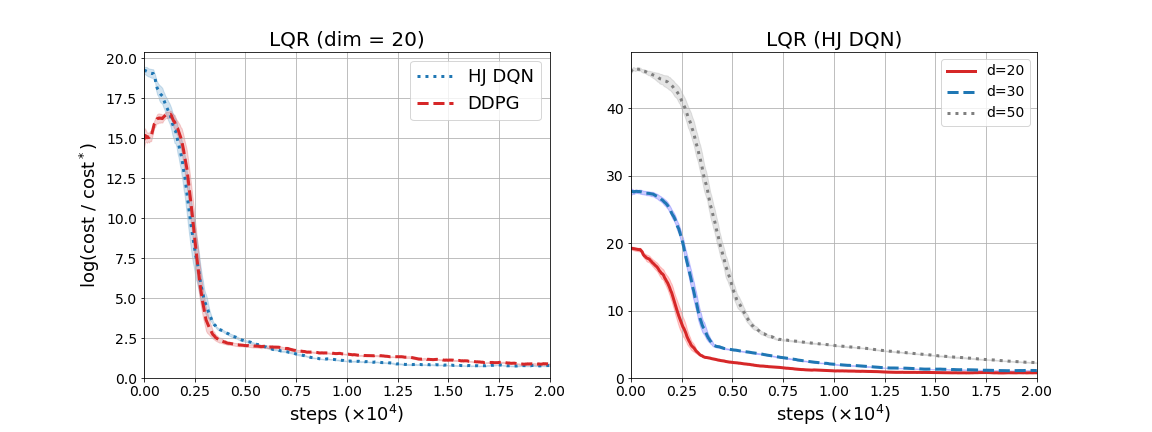This repository includes an official PyTorch implementation of Hamilton-Jacobi DQN (HJ DQN), and DDPG as a baseline. In addition to continuous control tasks from OpenAI Gym, we include results on high-dimensional Linear Quadratic Regulator problems.
To run our code, the followings must be installed:
For complete installation of mujoco-py, make sure you already have a MuJoCo activation key under ~/.mujoco.
We successfully run the codes with Python 3.6, Gym 0.15, Pytorch 1.4, and mujoco-py 2.0.2.
Once you have completed installation of all required packages, run the following command within a shell.
$ cd hjdqn && pip install -e .
It is recommended that you activate a separate virtual environment during installation.
We also provide custom gym environment to test algorithms on LQR tasks. To install these environments, move to gym_lqr folder and install the package as follows:
$ cd gym_lqr && pip install -e .
By doing so, you register these new environments to gym registry, which enables you to create LQR environment instances by simply calling make function. The following code will make a 20-dimensional LQR environment:
env = gym.make('LinearQuadraticRegulator20D-v0')
We provide a comprehensible interface for applying algorithms. For instance, to train a HJ DQN agent on HalfCheetah-v2 for 1 million steps, you may run the following command:
$ python main.py --algo=hjdqn --env=HalfCheetah-v2 --max_iter=1e6
You may specify the values of the hyperparameters of your agent.
For example, to set the size of control constraint and the learning rate,
add --L and --lr to your command as follows:
$ python main.py --algo=hjdqn --env=HalfCheetah-v2 --max_iter=1e6 --lr=5e-4 --L=30
Evaluation of the agent is done every 2000 steps of interactions by default.
You may adjust evaluation interval by simply adding the option --eval_interval.
During training, all of the training/evaluation logs are saved at the directory eval_log.
If you run DDPG on Hopper-v2, then the corresponding evaluation log will be written in .csv format,
and be located under eval_log/Hopper-v2/.
We provide a summary of the experimental results on MuJoCo benchmark problems.
For each task, we run HJ DQN for 1 million steps across 5 random seeds, and compared the score with that of DDPG.
To generate these plots, evaluation are done over 5 episodes every 2000 steps.
More concrete discussion and analysis of the result can be found in the paper.

We also tested our novel algorithm on high-dimensional Linear Quadratic Regulator(LQR) problems.
Since the default experimental setting of our code is MuJoCo-oriented, you need to adjust extra experiment-related parameters to successfully reproduce LQR experiments.
For instance, to reproduce the result over 20-dimensional LQR with HJ DQN, run the following command:
$ python main.py --env=LinearQuadraticRegulator20D-v0 --algo=hjdqn --L=10 --lr=1e-3 --max_iter=2e4 --ep_len=1 --eval_interval=50 --fill_buffer=0 --start_train=400 --batch_size=512 --gamma=0.99999
A detailed analysis of the result can be found in the paper. Here we include figures which show the experimental results at once.
